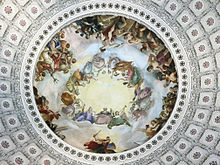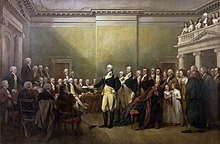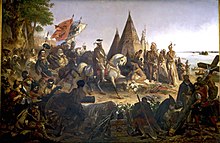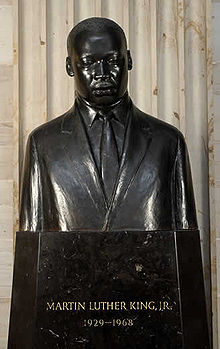Rotunda of the United States Capitol
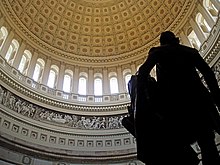
The rotunda is the central, round component of the Washington Capitol , which is located below the dome and is the largest component of the building. The rotunda is surrounded by corridors that connect the wings of the House of Representatives and the Senate . To the south of the rotunda is the semicircular National Statuary Hall , which was the House of Representatives boardroom until 1857. In the north-east of the rotunda is the former meeting room of the Senate, which was used until 1959.
The rotunda has a diameter of 29.26 m and reaches a height of 54.94 m in the middle of the dome. It is visited by thousands of people every day. It is also used for ceremonial occasions, such as the laying out of deserving people. This use must be approved by a concurrent resolution .
Design and construction
The architect William Thornton was the winner of the architectural competition to design the Capitol in 1793. He initially had the idea of a central rotunda. Due to a lack of funds and building materials, frequent construction stoppages and the British attack during the British-American War , construction on the rotunda did not begin until 1818. It was completed in 1824 under the supervision of the Architect of the Capitol Charles Bulfinch . The rotunda was part of a series of construction works in preparation for the Marquis de Lafayette's last visit in 1824. It was built in the style of revolutionary architecture and should be reminiscent of the Pantheon .
The sandstone walls of the rotunda are 15 m high, everything above belongs to the dome, which was designed in 1854 by Thomas Ustick Walter , the fourth architect of the Capitol. Walter also designed the north and south extensions of the Capitol. Due to the expansion of the structure, the capitol dome appeared too small. In 1856 construction began on a new cast iron dome. In 1859, work began on the rotunda. These were necessary to be able to carry the new larger and heavier dome. In 1862 Walter commissioned the painter Constantino Brumidi to create a fresco with a diameter of 20 m in the top of the dome.
Apotheosis of Washington
The Apotheosis of Washington is a large fresco in the top of the dome over the rotunda. It was made in 1865 by the Italian painter Constantino Brumidi. Brumidi had three years under Pope Gregory XVI. worked in the Vatican . He also worked in many palaces and villas of various nobles before emigrating to the United States in 1852. He spent most of the last 25 years of his life working at the Capitol. In addition to the Apotheosis of Washington , he designed the Brumidi Corridors .
American history frieze
The " Frieze of American History" looks like a bas-relief carved in stone, but is actually a trompe l'œil fresco cycle depicting 19 scenes from American history. The frieze is on a strip just below the 36 windows. Brumidi designed the frieze in 1859 and made a sketch, but did not begin work until 1878. He painted seven and a half scenes. While working on "William Penn and the Indians" he fell off the scaffolding and hung on the railing for 15 minutes until he was rescued. He died a few months later in 1880. After his death, Filippo Costaggini was commissioned to complete the frieze based on Brumidi's sketch. He finished his work in 1889. However, due to a mistake in Brumidi's original sketch, a nine-meter gap remained. In 1951, Allyn Cox completed the frieze.
The 19 scenes are:
| scene | description |
|---|---|

|
America and History
The first and only allegorical picture shows Columbia, a personification of America, in the center. She wears a liberty cap, a spear and a shield and is surrounded by other allegorical figures. On her right is an Indian woman with a bow and arrow. It stands for the wild North American continent. At her feet sits a woman who tells the story and writes the events on a blackboard. In front of the Columbia an eagle sits in its claws with a bundle of rods , the symbol of power. |

|
The landing of Columbus
The first of the four scenes about the Spanish conquest depicts the landing of Christopher Columbus in America. Columbus leaves Santa María over a plank while his armed crew waits on the ship. He is greeted by a group of Indians. In the left corner the story is depicted again with its tablet. |

|
Cortés and Moctezuma in a Mexican temple
This picture shows the Spanish conquistador Hernán Cortés , who is greeted by Moctezuma II as he enters an Aztec temple . At the beginning of the Spanish conquest of Mexico , Cortés was worshiped like a god by Moctezuma and the Aztecs, as he was mistaken for the returned god Quetzalcoatl . The Piedra del Sol and the idols are based on sketches that Brumidi made in Mexico City . |

|
Pizarro in Peru
The picture shows Francisco Pizarro in search of Eldorado , the legendary land of gold. It stands for the Spanish conquest of Peru . |

|
Burial de Sotos
This picture shows the funeral of Hernando de Soto in Mississippi after he died of a fever. In search of gold, silver and other valuables, de Soto led the largest European expedition of the 15th and 16th centuries through the Southeast and the Midwest . |

|
Captain Smith and Pocahontas
The picture shows Pocahontas as Captain John Smith , one of the founders of Jamestown (Virginia) saves lives. |

|
The landing of the pilgrims
This picture shows Pilgrim Fathers thanking God for their safe journey to Plymouth . |

|
William Penn and the Indians
The Quaker leader and founder of the Pennsylvania Colony , William Penn , is shown with Lenni Lenape Indians under an elm tree in Shackamaxon. This is the last picture Brumidi worked on. |

|
The colonization of New England
This picture shows settlers building a house in New England . It is Costaggini's first work. |

|
Oglethorpe and the Indians
James Oglethorpe , founder of Georgia Colony and first governor of Georgia, welcomes Muskogee leaders to Savannah, Georgia . The Muskogee present Oglethorpe with a buffalo skin with an eagle in the middle, the symbol of friendship and trust. |

|
Battle of Lexington
This picture shows the " shot heard around the world " during the Battle of Lexington , the first major battle in the Revolutionary War . Major John Pitcairn is shown on horseback in the center, with the British Army and Royal Marines behind him and the Lexington Militia in front . |

|
The declaration of Independence
The picture shows John Adams , Thomas Jefferson , and Benjamin Franklin , the authors of the United States Declaration of Independence , reading the declaration to celebrating colonists. |

|
Surrender of Cornwallis
In the picture, as a sign of surrender , George Washington receives the sword of Charles O'Hara on horseback, who represented Lord Cornwallis after the final defeat of the British at the Battle of Yorktown . In reality, he refused the sword because he only wanted to personally accept it from Cornwallis. Major General Benjamin Lincoln , however, accepted the sword. |

|
The death of Tecumseh
The Shawnee -Häuptling Tecumseh , during the Battle of the Thames in Upper Canada during the British-American war shot. |

|
The American army invades Mexico City .
US Army troops, led by Winfield Scott , enter the city after defeating the Battle of Mexico City. The battle ended the Mexican-American War with an American victory. Shortly thereafter, the Guadalupe Hidalgo Treaty was signed , in which Mexico gave up large areas of land to its neighboring country. |

|
Gold discovery in California
This scene shows the California gold rush . The person in the middle could be John Sutter . The first gold was found on the site of his Sutter's Mill sawmill . This picture was the last one designed by Brumidi and painted by Costaggini. |

|
Peace at the end of the civil war
A Confederate soldier and a Union Army soldier shake hands at the end of the American Civil War as a symbol of reconciliation and reunification. The cotton plant stands for the southern states and the pine stands for the northern states. |

|
Navy gun crew in the Spanish-American War
This scene depicts US Navy sailors operating a gun during a naval battle in the Spanish-American War of 1898. |

|
Aviation was born .
This picture shows the Wright brothers' first flight at Kitty Hawk in 1903. Orville Wright can be seen in the aircraft that has just taken off and Wilbur Wright is walking alongside the aircraft. On the left are Leonardo da Vinci , Samuel Pierpont Langley and Octave Chanute , other aviation pioneers, with models of the flying machines they designed. On the right is an eagle with an olive branch. |
History painting
In the rotunda there are large, framed history paintings in eight niches . These oil paintings painted on canvas are all 3.6 mx 5.5 m in size. Four of these pictures are about the American independence movement and were painted by John Trumbull , who was commissioned by Congress to do the work in 1817. These pictures are the Declaration of Independence , The Surrender of General Burgoyne , The Surrender of Lord Cornwallis and the resignation of General George Washington . They were hung between 1819 and 1824. Between 1840 and 1855 4 more pictures were hung. These show the discovery and colonization of America and were painted by various artists. These images are The Landing of Columbus by John Vanderlyn , The Discovery of the Mississippi by William Henry Powell , The Baptism of Pocahontas by John Gadsby Chapman, and The Embarkation of the Pilgrim Fathers by Robert Walter Weir .
The Declaration of Independence was the first painting that Trumbull completed for the rotunda. This symbolic picture is probably the most recognized painting in the rotunda. The painting was commissioned in 1817, purchased in 1819, and hung in 1826.
The Declaration of Independence shows John Adams , Roger Sherman , Robert R. Livingston , Benjamin Franklin , and its lead author, Thomas Jefferson , the five members of the Committee of Five, presenting the Declaration they drafted by the Second Continental Congress and President John Hancock in July 1776 at Independence Hall in Philadelphia .
The painting is not entirely historically correct and somewhat anachronistic. Of the 56 signatories of the Declaration of Independence, only 42 are shown. The rest are missing, possibly because they were absent when the Declaration of Independence was adopted or had already died when Trumbull painted the picture. There are 4 men in the picture who have not signed the declaration: George Clinton , Robert R. Livingston, Thomas Willing and John Dickinson . A reproduction of the picture is on the 2 dollar bill.
General Burgoyne's surrender was commissioned in 1817, purchased in 1822, and hung in 1826. It shows the surrender of the British soldiers under General John Burgoyne after the American victory at the Battle of Saratoga in 1777. This battle was an important victory for the Americans, it prevented the division of New England and secured the military support of the Americans French people. The central figure is the Continental Army general, Horatio Gates , who refused to accept the sword that Burgoyne offered him. Instead, he treated his former enemy like a gentleman and invited him into his tent.
Lord Cornwallis' surrender was commissioned in 1817 and hung in 1820. It shows the final surrender of the British after the Battle of Yorktown in 1781. In this battle an American-French force led by George Washington, the Marquis de Lafayette , and the Comte de Rochambeau triumphed over the British troops led by Lord Cornwallis . The surrender led to the end of hostilities in the great war of freedom and the recognition of American independence through the peace of Paris .
The picture shows the same event as the panel painting “The Surrender of Cornwallis” in the “Frieze of American History”. The American General Benjamin Lincoln is shown in the middle on a white horse. On the left are French officers and on the right are American officers, under the leadership of Washington, on a brown horse. The British are represented by officers. Lord Cornwallis was not present in person, but was represented by Charles O'Hara. Because of this, Washington refused to accept O'Hara's sword, since, as was customary at the time, he could only accept the sword from Cornwallis personally; Maj. General Lincoln accepted the sword in Washington's place. Trumbull was proud of the fact that he had portrayed French officers during a stay in France. On the right side, he has added a self-portrait below the American flag.
General George Washington's resignation was commissioned in 1817 and hung in 1824. The picture shows George Washington as he announcedhis resignation from his post as Commander-in-Chief of the Continental Armybefore Congress on December 23, 1783. Congress was then in session at the Maryland State House in Annapolis . This famous event established the strong tradition of civilian control of the military in the United States and the rejection of a military dictatorship in favor of free democracy.
Washington is shown with two aides-de-camps as he declares his resignation to the President of Congress. In addition, Thomas Mifflin , Elbridge Gerry , Thomas Jefferson , James Monroe and James Madison to see on the image. Martha Washington and her three grandchildren can be seen on the balcony , although she was not actually there.
The landing of Columbus was commissioned in 1836/1837 and hung in 1847. The painting by John Vanderlyn shows Christopher Columbus landing on San Salvador (local name Guanahani ), West Indies , on October 23, 1492.
With the royal flag, Columbus claims land for Spain. The captains of the Niña and Pinta follow him with the flags of the Catholic Kings , Isabella I of Castile and Ferdinand II of Aragon . Part of the team has been taken, another is looking for gold on the beach. On the right side you can see some residents of the island.
The discovery of the Mississippi was the last painting commissioned by Congress for the rotunda. William Henry Powell received the commission in 1847 and in 1855 the painting was purchased. In the middle of the screen you can see the Spanish navigator and conquistador Hernando de Soto on a gray horse. De Soto is considered the first European to see the Mississippi River in 1541. The picture shows de Soto and his troops approaching Indiansstanding infront of their tipis . The chief offers de Soto the pipe of peace . Guns and soldiers are shown in the foreground. They stand for the devastating battle of Mauvilla (also Mabila), in which de Soto won a Pyrrhic victory over the Choctaw Indians from chief Tuscaloosa.
The Baptism of Pocahontas was painted by John Gadsby Chapman, who received the commission in 1837. The painting was hung in 1840. It shows Pocahontas in a white dress, while from the Anglican priest Alexander Whiteaker in Jamestown (Virginia) on the name Rebecca is baptized. This event is said to have taken place in the year 1613 or 1614. She kneelsbefore the priest in front ofher family including her father Powhatan and the colonists. Her brother Nantequaus has turned away from the ceremony. The baptism was performed before the wedding with the Englishman John Rolfe , who stands behind her. Their connection is considered to be the first recorded marriage between a European and an Indian woman. The picture symbolizes the view of some Americans of the time that the native tribes should accept Christianity and other European customs.
The embarkation of the Pilgrim Fathers was commissioned in 1837 and hung in 1844. The picture painted by Robert W. Weir shows pilgrims on their departure from Delfshaven in South Holland on July 22nd, 1620 on the deck of the Speedwell ship. The Pilgrim Fathers traveledto Southampton aboard the Speedwell . There they met other colonists and switched to the Mayflower . The picture shows William Brewster with the Bible and Pastor John Robinson in prayer with Governor John Carver , William Bradford , Miles Standish and their families. The rainbow on the left symbolizes hope and divine protection.
Statuary Hall Collection
In the rotunda are four statues from the National Statuary Hall Collection:
- Dwight D. Eisenhower in bronze, from Kansas , by Jim Brothers in 2003.
- James A. Garfield in marble, from Ohio , by Charles Niehaus from 1886.
- Andrew Jackson in bronze, from Tennessee , by Belle Kinney Sholz and Leopold F. Sholz, from 1928.
- George Washington , in bronze, from Virginia , by Jean-Antoine Houdon from 1934.
The four presidents remain in the rotunda indefinitely or until another legislative decision by Congress.
Monuments
Martin Luther King
To this day, Martin Luther King is the only African American to be honored with a bust in the Capitol. The bust of his head and upper body is 91 cm high and stands on a 168 cm high, pyramidal base made of black Belgian marble. Martin Luther King is depicted in a thoughtful, peaceful mood and with a slightly lowered gaze. His face is well modeled, in contrast to the structures of his hair, jacket and tie. The base was designed by the sculptor to follow the line of the bust's shoulders. This creates a uniform shape and reinforces the imposing impression.
On December 21, 1982, Concurrent Resolution 153 passed Congress. This ordered the creation of a bust of Martin Luther King to commemorate his services to civil rights and the right to vote, which had been in effect since the 1960s. Senator Charles Mathias Jr., chairman of the Joint Committee on the Library , the congressional committee responsible for overseeing the orders, said at the unveiling of the bust: "Martin Luther King is given his due place among the heroes of this nation."
Since this was an extremely important work of art, the Joint Committee on the Library decided to hold a national selection competition for the artist. At the end of this competition on April 15, 1985, John Wilson was selected as the winner. He received $ 50,000 for making the bronze bust. The bust was unveiled in the rotunda by his wife Coretta King on the 75th birthday of Martin Luther King, January 16, 1986 . She was accompanied by her four children and her sister-in-law.
Women's movement for the right to vote
The memorial, entitled The Portrait Monument, features three pioneers of the American women's movement. It commemorates the enforcement of women's suffrage , which was achieved with the creation of the 19th amendment in 1920. The memorial was carved out of an 8-ton block of marble by Adelaide Johnson in Carrara , Italy . It shows busts of the leaders of the women's movement. These are copies of the busts displayed in the women's building at the World's Columbian Exposition in 1893. The memorial was a gift from the National Woman's Party to the Capitol. It was adopted on behalf of Congress by the Joint Committee on the Library on February 10, 1921. The unveiling ceremony took place on February 15, 1921 in the rotunda. This was Susan B. Anthony's 101st birthday. Representatives of over 70 women's movements took part. The monument was then exhibited in the crypt until it was returned to the rotunda in May 1997 based on Concurrent Resolution 216. The memorial shows:
- Elizabeth Cady Stanton (1815–1902), president of the National Woman Suffrage Association from 1865 to 1893; Writer of the Fundamental Rights of Women , read at the Seneca Falls, New York congregation in 1848; she was the first to advocate women's suffrage.
- Susan B. Anthony (1820–1906), slavery opponent, representative of the abstinence movement and later president of the National American Woman Suffrage Association , which campaigned with Stanton in 1851 for women's suffrage. She proposed the constitutional amendment, which was only implemented after her death.
- Lucretia Mott (1793–1880), reformer and preacher to the Quakers. She fought for the abolition of slavery, peace and equal rights for women in work and education. She organized the Seneca Falls gathering in 1848, which gave rise to the women's movement.
More statues and artifacts
In addition to the statues from the National Statuary Hall Collection and the two memorials, there are other exhibits in the rotunda. Near the south entrance, across from the statue of George Washington, is a bronze statue of Thomas Jefferson with the Declaration of Independence. This gift from Jefferson Levy is the only work of art in the Capitol that was donated by a private individual. The west entrance has marble statues of General Ulysses S. Grant and President Abraham Lincoln . The Lincoln statue was commissioned by Congress and designed by Vinnie Ream . The statue of Grant was a gift from the Grand Army of the Republic to Congress. In the southwestern part of the rotunda stands the statue of Alexander Hamilton . Across from Hamilton is a copy of the Magna Carta in a gold box. This was a gift the United States received on its bicentenary.
Lying in State and Honor
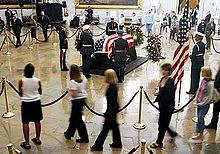

Deserved people are laid out in the rotunda after their death. In the USA , a distinction is made between Lying in State (the wake is carried out by a military honor guard) and Lying in Honor (the wake is carried out by an honor guard of the United States Capitol Police ).
The following Americans were laid out in the rotunda:
- Lying in State
- Senator Henry Clay (1852), first lay in the Capitol.
- President Abraham Lincoln (1865)
- Deputy Thaddeus Stevens (1868)
- Senator Charles Sumner (1874)
- Vice President Henry Wilson (1875)
- President James A. Garfield (1881)
- Union Forces General John A. Logan (1886)
- President William McKinley (1901)
- Washington's urban planner Pierre L'Enfant (1909)
- Admiral George Dewey (1917)
- Unknown soldier of the First World War (1921)
- President Warren G. Harding (1923)
- President and President of the Supreme Court William Howard Taft (1930)
- General John J. Pershing (1948)
- Unidentified soldiers of World War II and the Korean War (1958)
- President John F. Kennedy (1963)
- General Douglas MacArthur (1964)
- President Herbert Hoover (1964)
- President Dwight D. Eisenhower (1969)
- Senator Everett Dirksen (1969)
- FBI Director J. Edgar Hoover (1972)
- President Lyndon B. Johnson (1973)
- Vice President Hubert H. Humphrey (1978)
- Unidentified Soldier of the Vietnam War (1984)
- House of Representatives Claude Pepper (1989)
- President Ronald Reagan (2004)
- President Gerald Ford (2006-2007)
- Senator and Medal of Honor holder Daniel Inouye (2012)
- Senator John McCain (2018)
- President George HW Bush (2018)
- Civil rights activist and MP John Robert Lewis (2020)
- Lying in Honor:
- Officers Jacob Chestnut and John Gibson (1998) who were shot dead by the culpable Russell Eugene Weston Jr. while serving in the Capitol. (Chestnut was the first African American to be laid out in the Capitol.)
- The civil rights activist Rosa Parks : The first woman and also the second African-American person to be laid out in the Capitol (2005).
- The famous evangelist Billy Graham (2018).
literature
- Harald Klinke: American history painting. New pictures for the New World. Graphentis Verlag, Göttingen 2011, ISBN 978-3-942819-00-8
Individual evidence
- ↑ Harald Klinke: American history painting. New pictures for the New World. Graphentis Verlag, Göttingen 2011, ISBN 978-3-942819-00-8 , Chapter 2 and 3.
- ^ A b Declaration of Independence. Architect of the Capitol. [1]
- ^ "The Declaration of Independence by John Trumbell." Americanrevolution.org. [2] ( Page no longer available , search in web archives ) Info: The link was automatically marked as defective. Please check the link according to the instructions and then remove this notice.
- ↑ "Facts About $ 2 Notes." Bureau of Engraving and Printing, United States Department of the Treasury. Archived copy ( memento of the original from October 7, 2006 in the Internet Archive ) Info: The archive link was inserted automatically and has not yet been checked. Please check the original and archive link according to the instructions and then remove this notice.
- ↑ Surrender of General Burgoyne
- ^ Surrender of Cornwallis
- ^ Washington's resignation
- ↑ Landing of Columbus
- ^ Discovery of the Mississippi
- ↑ Embarkation of the Pilgrims
- ↑ Martin Luther King, Jr
- ^ Women's Suffrage
- ↑ Infosite of the Capitol
- ↑ Billy Graham's body laid out in the US Capitol. In: epd.de. Archived from the original on May 14, 2018 ; accessed on May 13, 2018 .
Coordinates: 38 ° 53 '23.6 " N , 77 ° 0' 32.6" W.

